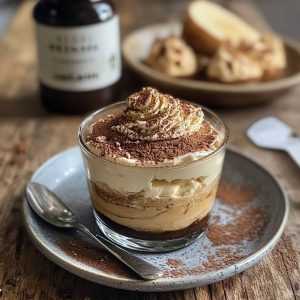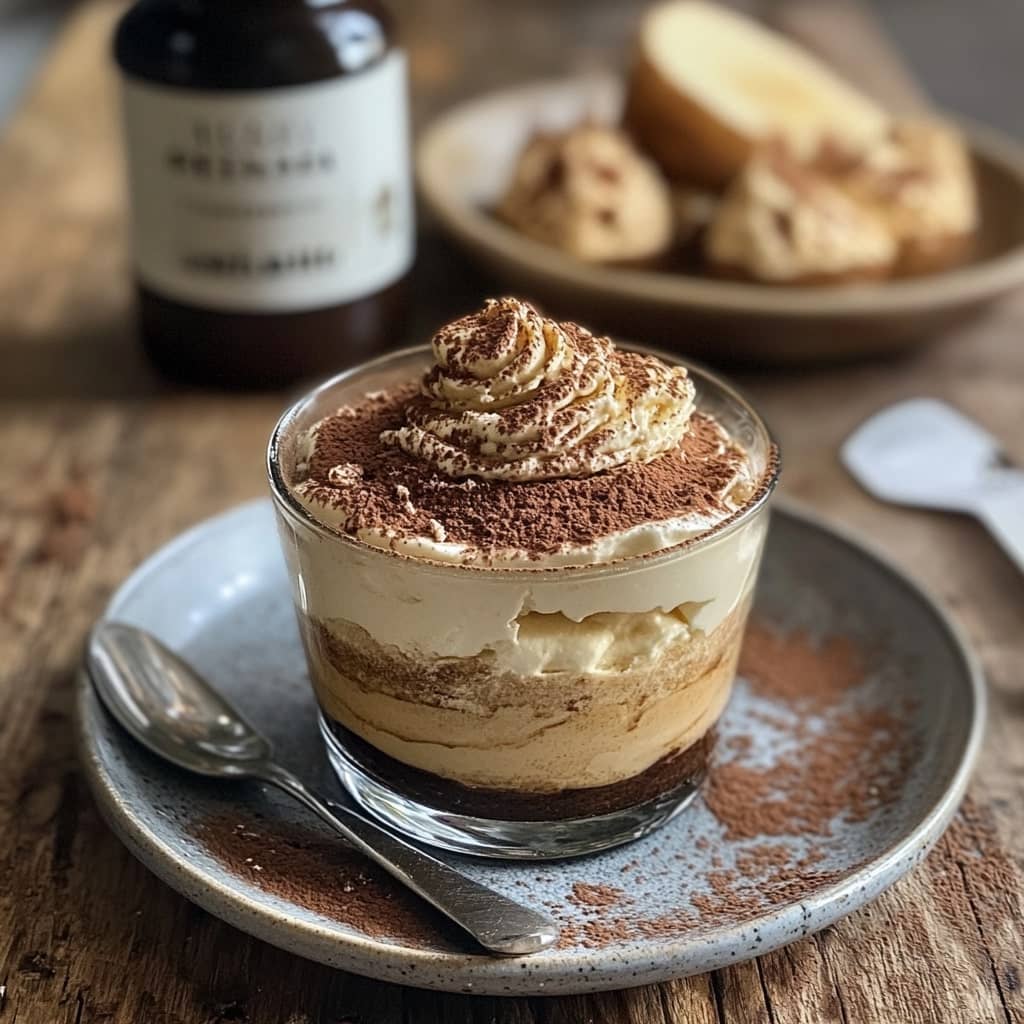Introduction
Classic tiramisu is the quintessential Italian dessert, beloved worldwide for its rich, creamy texture, bold coffee flavor, and irresistible layers of sweetness balanced by a subtle bitterness from cocoa and espresso. Known for its indulgent yet airy consistency, this no-bake dessert combines delicate ladyfingers soaked in espresso with a velvety mascarpone filling, layered into a chilled, sliceable treat that melts in your mouth. Despite its luxurious appearance and complex taste, tiramisu is surprisingly simple to prepare at home, making it a go-to choice for dinner parties, holiday gatherings, or anytime you crave an elegant dessert. Revered for its ability to be made in advance, tiramisu has become a timeless favorite that adapts beautifully to both traditional methods and modern variations.
The History of Tiramisu
Tiramisu, which translates to “pick me up” in Italian, is a relatively modern classic that dates back to the 1960s, believed to have originated in the Veneto region of Italy, particularly Treviso. While several families and restaurants claim to have invented it, the most commonly accepted story credits the dessert to the restaurant Le Beccherie, where it was crafted as a luxurious, energizing treat combining coffee, eggs, sugar, and mascarpone. The original recipe did not include alcohol, though many modern interpretations do. It quickly gained popularity across Italy and later around the globe, especially in the United States during the 1980s and 1990s, where it became a staple in Italian restaurants. As tiramisu spread internationally, it evolved to include variations with cream, liqueurs, chocolate, and even fruit, but the core concept—soaked ladyfingers layered with creamy filling—has remained unchanged. Its enduring appeal lies in its perfect balance of flavors and textures, and the nostalgic comfort it offers with each bite.
Ingredients Breakdown
- Ladyfingers (Savoiardi): Crisp, sponge-like biscuits that become soft and cake-like after being dipped in coffee, providing the structure for the layers.
- Espresso or Strong Coffee: The foundation of tiramisu’s bold flavor; used to soak the ladyfingers, sometimes sweetened or spiked with liqueur.
- Mascarpone Cheese: An Italian cream cheese that gives the filling its creamy, rich texture without being overly tangy.
- Egg Yolks: Used in the traditional zabaglione-style filling to create a smooth, custard-like base when cooked with sugar.
- Granulated Sugar: Sweetens the mascarpone mixture and balances the bitterness of the coffee and cocoa.
- Heavy Cream (optional): Often added to lighten the mascarpone mixture and add volume, especially in eggless versions.
- Coffee Liqueur (optional): Such as Kahlúa, Marsala, or brandy, used to deepen the flavor of the coffee soak.
- Cocoa Powder: Sifted over the top layer for a classic finishing touch and a hint of chocolate bitterness.
- Dark Chocolate (optional): Shaved or grated over the top for added richness and presentation.
Step-by-Step Recipe
- Prepare the Coffee Soak: Brew 1½ cups of strong espresso or coffee and let it cool. Stir in 3 tablespoons of coffee liqueur if desired, and set aside in a shallow dish.
- Make the Zabaglione (Traditional Method): In a heatproof bowl set over a pot of simmering water (double boiler), whisk together 4 large egg yolks and ½ cup granulated sugar. Continue whisking over gentle heat until the mixture thickens and becomes pale and creamy (about 8–10 minutes). Remove from heat and let cool slightly.
- Prepare the Mascarpone Filling: In a large mixing bowl, gently fold 16 oz of mascarpone cheese into the cooled zabaglione mixture until smooth.
- Whip the Cream (if using): In a separate bowl, whip 1 cup of heavy cream until stiff peaks form, then gently fold it into the mascarpone mixture to lighten the texture.
- Assemble the Tiramisu: Quickly dip each ladyfinger into the cooled coffee mixture for 1–2 seconds per side. Arrange them in a single layer in the bottom of a 9×13-inch dish or similar container. Spread half of the mascarpone filling evenly over the soaked ladyfingers. Repeat with another layer of dipped ladyfingers, followed by the remaining mascarpone mixture.
- Chill and Finish: Cover the tiramisu and refrigerate for at least 4 hours, preferably overnight. Just before serving, dust the top generously with unsweetened cocoa powder using a fine-mesh sieve. Garnish with chocolate shavings or espresso beans if desired.
Tips for the Perfect Tiramisu
Use high-quality espresso or coffee for the best flavor, and let it cool completely before dipping the ladyfingers. Do not oversoak the ladyfingers—just a quick dip to prevent them from becoming mushy. Use fresh, high-quality mascarpone for a smooth, creamy texture. If you’re using raw eggs, make sure they’re pasteurized or cook the yolks as in the zabaglione method to ensure food safety. Chill the tiramisu for several hours or overnight to allow the layers to firm up and flavors to develop fully. Always dust cocoa powder just before serving to keep the top looking fresh and prevent moisture absorption. For clean slices, wipe your knife between cuts. If serving at an event, consider using a piping bag to layer the cream for a neater presentation.
Variations and Customizations
Alcohol-Free: Skip the liqueur and use vanilla extract or almond extract in the coffee mixture.
Egg-Free Tiramisu: Use whipped cream and mascarpone instead of zabaglione for a quicker, lighter version.
Tiramisu Cups: Assemble in individual serving glasses for portion control and elegant presentation.
Chocolate Tiramisu: Add layers of chocolate ganache or cocoa-infused mascarpone for extra richness.
Fruit Tiramisu: Incorporate sliced strawberries, raspberries, or a fruit compote between layers for a fruity twist.
Vegan Tiramisu: Use dairy-free mascarpone alternatives, coconut whipped cream, and egg-free sponge cake.
Gluten-Free Tiramisu: Use gluten-free ladyfingers or substitute with gluten-free sponge cake.
Health Considerations and Nutritional Value
Tiramisu is a rich dessert, often containing eggs, cream, and sugar, with a single serving averaging between 300 and 450 calories. The mascarpone and whipped cream contribute to its high fat content, while the sugar and ladyfingers add significant carbohydrates. However, it does provide moderate calcium and protein. To make it lighter, use reduced-fat mascarpone, lower sugar amounts, or a sugar substitute. Eggless and alcohol-free versions may be better suited for children or those with dietary restrictions. For gluten intolerance, choose certified gluten-free ladyfingers. Vegan versions require plant-based substitutions but can still deliver the layered texture and flavor. As with most desserts, tiramisu is best enjoyed in moderation, and portion control or ingredient adjustments can make it suitable for a wider range of dietary needs.
FAQ
Can I make tiramisu ahead of time? Yes, tiramisu tastes even better when made a day in advance, allowing the flavors to meld and the texture to set.
How long can tiramisu be refrigerated? Store it covered in the refrigerator for up to 3 days.
Can I freeze tiramisu? Yes, tiramisu can be frozen (without cocoa powder on top) for up to 3 months. Thaw overnight in the fridge and dust with cocoa before serving.
Do I have to use raw eggs? Traditional tiramisu uses raw yolks, but you can cook them into a zabaglione or opt for egg-free versions.
What can I use instead of mascarpone? A mix of cream cheese and heavy cream can substitute in a pinch, though it alters the flavor slightly.
Can I make it alcohol-free? Absolutely—simply omit the liqueur and replace with extract or extra coffee.
Can kids eat tiramisu? Yes, if it’s made without alcohol and raw eggs, or if pasteurized eggs are used.

Classic Tiramisu Recipe
Ingredients
Mascarpone Cream:
- 16 oz 450g cold mascarpone cheese
- 4 egg yolks
- ¾ cup 165g granulated sugar — if incorporating egg whites, divide the sugar into two equal portions
- 1 teaspoon vanilla extract
- A pinch of salt
- 1½ cups 360g heavy cream or 4 egg whites (for a lighter version)
Assembly:
- Approximately 30 ladyfinger cookies
- 1½ cups strong black coffee
- 2 tablespoons unsweetened cocoa powder for dusting
Instructions
Mascarpone Cream – Option 1: Using Heavy Cream (Recommended)
- Begin by whisking the cold mascarpone cheese on medium speed for 30 to 60 seconds until it becomes smooth and creamy. Set it aside. In a separate heatproof bowl, combine the egg yolks and sugar. Bring 1 to 2 inches of water to a gentle boil in a saucepan, then reduce the heat to the lowest setting. Place the bowl of yolks and sugar over the saucepan, ensuring the bottom of the bowl does not touch the water. Whisk the mixture on medium-high speed for exactly 2 minutes, then remove it from the heat. Pour the warm egg yolk-sugar mixture into the mascarpone cheese. Add the vanilla and a pinch of salt, and whisk on medium speed just until everything is incorporated—do not overmix, as this can make the mixture grainy. In a separate bowl, whip the cold heavy cream until stiff peaks form, being careful not to overbeat. Fold the whipped cream into the mascarpone mixture in 2 to 3 additions using a rubber spatula, gently folding to retain as much air as possible for a light and airy texture.
Mascarpone Cream – Option 2: Using Egg Whites
- Start by whisking the cold mascarpone cheese on medium speed for 30 to 60 seconds until smooth and creamy. Set it aside. In a separate heatproof bowl, add the egg yolks and half of the sugar. In a saucepan, bring 1 to 2 inches of water to a gentle boil and lower the heat. Place the bowl over the saucepan, making sure the bottom of the bowl does not come into contact with the water. Whisk the mixture on medium-high speed for exactly 2 minutes, then remove from the heat. Pour this egg yolk mixture into the mascarpone, then add vanilla and a pinch of salt. Whisk just until combined—be cautious not to overmix. In another clean bowl, add the egg whites and the remaining sugar. Place this bowl over the saucepan of simmering water and whisk until the mixture reaches 160°F. Remove from heat and continue whisking until a glossy meringue with stiff peaks forms. Fold the meringue into the mascarpone mixture in 2 to 3 additions, gently incorporating it with a rubber spatula to keep the mixture light and airy.
Assembly and Serving
- Pour the prepared coffee into a shallow, wide bowl. Working one at a time, dip each ladyfinger briefly into the coffee—just a quick dip on each side, or up to 1 to 2 seconds per side if you prefer a softer texture. Arrange a layer of dipped ladyfingers on the bottom of a 7×11-inch rectangular dish. Spread half of the mascarpone cream mixture evenly over the ladyfingers. Add a second layer of dipped ladyfingers and top with the remaining mascarpone cream. You can spread it evenly or pipe it on in decorative dollops for a more elegant look. Cover the tiramisu tightly and refrigerate for at least 4 hours, or ideally overnight, to let the flavors develop and the dessert firm up. When ready to serve, sift a generous layer of cocoa powder over the top using a fine mesh sieve. Slice into squares and serve chilled.

